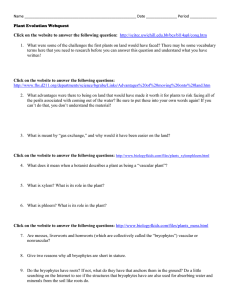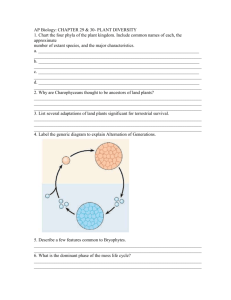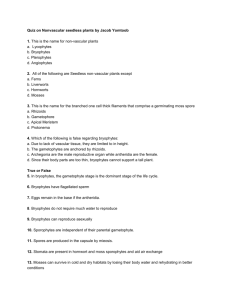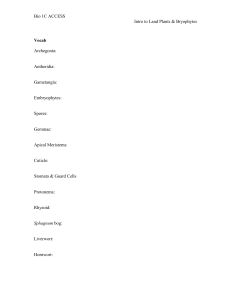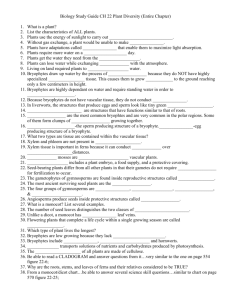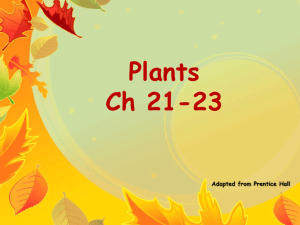Biology Slide 1 of 33 End Show
advertisement
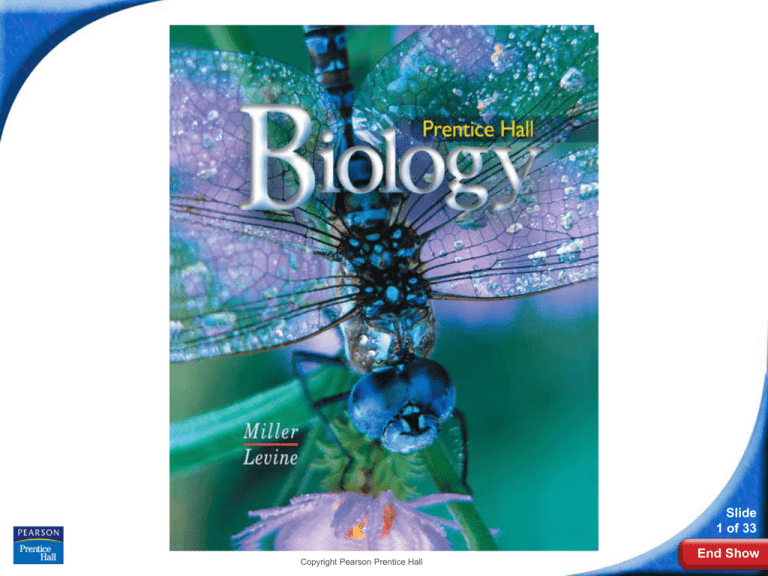
Biology Slide 1 of 33 Copyright Pearson Prentice Hall End Show 22–2 Bryophytes Slide 2 of 33 Copyright Pearson Prentice Hall End Show 22–2 Bryophytes Groups of Bryophytes Mosses and their relatives are called bryophytes, or nonvascular plants. They do not have vascular tissues, or specialized tissues that conduct water and nutrients. Slide 3 of 33 Copyright Pearson Prentice Hall End Show 22–2 Bryophytes Groups of Bryophytes Bryophytes have life cycles that depend on water for reproduction. Bryophytes draw up water by osmosis only a few centimeters above the ground. Slide 4 of 33 Copyright Pearson Prentice Hall End Show 22–2 Bryophytes Groups of Bryophytes The three groups of bryophytes are: • mosses • liverworts • hornworts Slide 5 of 33 Copyright Pearson Prentice Hall End Show 22–2 Bryophytes Groups of Bryophytes Mosses The most common bryophytes are mosses. Mosses: • are adapted to life in wet habitats and nutrientpoor soils. • can tolerate low temperatures. • are clumps of gametophytes growing together. Slide 6 of 33 Copyright Pearson Prentice Hall End Show 22–2 Bryophytes Groups of Bryophytes Capsule The Structure of a Moss Sporophyte Stalk Stemlike structure Gametophyte Leaflike structure Rhizoid Copyright Pearson Prentice Hall Slide 7 of 33 End Show 22–2 Bryophytes Human Use of Mosses Human Use of Mosses Sphagnum mosses thrive in the acidic water of bogs. Dried sphagnum acts as a natural sponge. It can accumulate to form peat deposits. Peat can be cut from the ground and used as fuel. Peat can be used to improve the soil’s ability to retain water and to increase soil acidity. Slide 8 of 33 Copyright Pearson Prentice Hall End Show 22–2 Click to Launch: Continue to: - or - Slide 9 of 33 End Show Copyright Pearson Prentice Hall 22–2 Unlike all other plants, bryophytes do NOT have a. vascular tissue. b. chlorophyll. c. gemmae. d. cell walls. Slide 10 of 33 End Show Copyright Pearson Prentice Hall 22–2 Water moves from the soil into the stemlike and leaflike structures of bryophytes by a. osmosis. b. active transport. c. specialized conducting structures. d. vascular tissue. Slide 11 of 33 End Show Copyright Pearson Prentice Hall 22–2 The most abundant bryophytes are the a. liverworts. b. mosses. c. hornworts. d. ferns. Slide 12 of 33 End Show Copyright Pearson Prentice Hall 22–2 Fertilization in bryophytes is dependent upon the presence of a. water. b. sunlight. c. nutrients. d. wind. Slide 13 of 33 End Show Copyright Pearson Prentice Hall 22–2 The stage of a moss plant that carries out most photosynthesis is the green a. gametophyte. b. sporophyte. c. protonema. d. zygote. Slide 14 of 33 End Show Copyright Pearson Prentice Hall END OF SECTION
